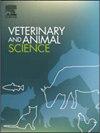Influence of paeoniflorin dietary supplementation on growth performance, antioxidant status, blood parameters, carcass characteristics and meat quality in broiler chickens
IF 1.9
Q2 AGRICULTURE, DAIRY & ANIMAL SCIENCE
引用次数: 0
Abstract
Paeonia lactiflora Pall, known for its antioxidative and anti-apoptotic properties, is a traditional Chinese medicine. To address the growing demand for animal protein, large-scale commercial broiler production systems often induce excessive stress responses in chickens, impacting their performance and immune function. This study examined the effects of adding paeoniflorin at doses of 150, 300, and 450 mg/kg to broiler diets on antioxidant activities, blood biochemical parameters, carcass characteristics, and meat quality. The results showed that different levels of paeoniflorin significantly enhanced the activity of antioxidant enzyme in serum and liver, and decreased in malondialdehyde level both in serum and meat tissue compared with basal diet broilers (P < 0.05). Paeoniflorin supplementation markedly decreased levels of creatinine, uric acid, aspartate aminotransferase, alanine aminotransferase, total cholesterol, and triglycerides (P < 0.05). Diets containing different levels of paeoniflorin significantly increased the eviscerated yield percentage of birds and reduced abdominal fat (P < 0.05). Furthermore, paeoniflorin supplementation notably enhanced the redness and reduced the yellowness of pectoral and thigh muscles, while also significantly decreasing drip and cooking loss in the pectoral muscle (P < 0.05). Although the levels of crude protein, ether extract, and crude ash in the pectoral and thigh muscles did not significantly vary between treatments (P > 0.05), paeoniflorin significantly increased the nucleotide 5′-monophosphate content in meat muscles (P < 0.05). Therefore, the data suggest that paeoniflorin can be an effective natural feed additive for broiler diets, with an optimal dosage of 150–300 mg/kg.
饲粮中添加芍药苷对肉鸡生长性能、抗氧化状态、血液参数、胴体特性和肉品质的影响
芍药是一种中药,具有抗氧化和抗细胞凋亡的特性。为了满足对动物蛋白日益增长的需求,大规模的商业肉鸡生产系统往往会引起鸡的过度应激反应,影响其生产性能和免疫功能。本试验研究了在肉鸡饲粮中添加150、300和450 mg/kg芍药苷对肉鸡抗氧化活性、血液生化指标、胴体特性和肉品质的影响。结果表明:与基础日粮肉鸡相比,不同水平的芍药苷显著提高了肉鸡血清和肝脏中抗氧化酶活性,降低了肉鸡血清和肉组织中丙二醛水平(P <;0.05)。补充芍药苷可显著降低肌酐、尿酸、天冬氨酸转氨酶、丙氨酸转氨酶、总胆固醇和甘油三酯水平(P <;0.05)。饲粮中添加不同水平的芍药苷可显著提高禽类净膛率,降低腹部脂肪(P <;0.05)。此外,添加芍药苷显著增强了胸肌和大腿肌的红度,降低了黄度,同时显著降低了胸肌的滴水和蒸煮损失(P <;0.05)。尽管胸肌和大腿肌粗蛋白质、粗脂肪和粗灰分水平在不同处理间无显著差异(P >;0.05),芍药苷显著提高了肉肌肉中核苷酸5′-单磷酸含量(P <;0.05)。综上所述,芍药苷可作为一种有效的肉鸡饲粮天然饲料添加剂,其最佳添加量为150 ~ 300 mg/kg。
本文章由计算机程序翻译,如有差异,请以英文原文为准。
求助全文
约1分钟内获得全文
求助全文
来源期刊

Veterinary and Animal Science
Veterinary-Veterinary (all)
CiteScore
3.50
自引率
0.00%
发文量
43
审稿时长
47 days
 求助内容:
求助内容: 应助结果提醒方式:
应助结果提醒方式:


